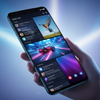Honor Announces Global Rollout of Revolutionary Eye-Tracking Feature
Introduction
As the smartphone industry keeps on evolving, their brands continue to hurry up forms of innovation that would better ameliorate the user experience. Among the various leading names in the sphere of smartphones, Honor will very recently launch its eye-tracking feature into the global market—a technology conceptualized to revolutionize consumer usage of devices. This novel feature has attracted the interest of many, mostly in India, where the tech-savvy consumer has spread its wings in search of new gadgets with up-to-date features.
In this newsletter, we delve into the details of Honor's upcoming eye-tracking technology, its possible implications in the Indian market, and what it would mean for pioneering future technologies changing the way we interact with smartphones. We also look into the pricing strategy for this feature in India, discuss its advantages, possible limitations, and questions usually asked to get a detailed understanding of this exciting development.
What is Honor's Eye-Tracking Feature?
This feature with advanced technology from the Honor brand enables a smartphone to track and react to the gaze of the user. It applies front cameras with complex algorithms to gather details on the exact point of looking on the screen. It enables your devices, through fixed gazes or looking points, to do things like scrolling through content while viewing, pausing videos, or even unlocking your phone.
This is particularly useful in hands-free situations, providing access for the most disabled while simply offering one more intuitive way of interacting with your smartphone. This feature in the phone corresponds to the continuity of Honor in the creation of AI-infused, machine-learning-driven gadgets that are making it smarter and more responsive to users.
The Indian Market Perspective
India is one of the fastest-growing mobile markets globally, supporting a heterogeneous and dynamic customer base. The country is home to millions of tech enthusiasts who are quick at adopting new technologies, which makes it an important market for smartphone brands. By rolling out the eye-tracking feature across the world, even in India, Honor has played this up as a very bold, strategic step toward reviving presence in the said region.
Indian customers are not afraid to walk away from a bad bargain. They want premium features at a competitive price, and possibly bringing the eye-tracking technology would resonate well with their customers. Secondly, its possibly diverse applications, including its application in the gaming and content consumption space, besides its use cases in accessibility, represent key features in Honor's smartphones.
Price in India: A Strategic Approach
Talking of pricing, the definition of volume that Honor expands on with its premium feature is discerning while still even more practical. The eye-tracking feature is not likely to be very expensive and, therefore, is certainly supposed to get nearer to every Indian.
In this respect, Honor will be starting the price of phones equipped with the eye-tracking feature at something like ₹20,000 to ₹25,000. Pretty competitive pricing for the technology, more so when you consider the kind of technology to be employed. Consequently, it will allow proper targeting for the mid-level segment that is very popular within India where smartphones are concerned.
In some flagship models, the price could further be increased to ₹40,000 and ₹50,000 due to more value-added high-end specifications. But mostly, these models will be all loaded with a host of other premium features that make them an attractive option for consumers looking for a best-in-class experience.
Pricing will be one of these critical success factors for implementing the eye-tracking feature by Honor in India. By pricing it in a highly competitive manner for this technology, it will help Honor gain the large consumer segments who are willing to adopt new technologies at affordable prices.
Potential Applications of Eye-Tracking Technology
The functionality of eye tracking has a lot of applications that can enhance the experience of using a smartphone. Some of the ways are presented below.
1. Hands-Free Navigation:
Users can scroll through websites, social media feeds, or even e-books by simply looking at the screen, which is very important in truly touchless situations when the hands are full.
2. Smart Screen Control:
The smartphone will adjust screen brightness automatically or paused videos on what the user is looking at. For example, when the user looks away from the screen, it will automatically pause and later resume when the user looks back.
3. Enhanced Gaming Experience:
Most popular for its enhanced level of gaming experience, exact eye tracking in the gaming industry, viewpoint changing, or even targeting the enemy, this feature is going to take mobile gaming enthusiasts in the country to an unparalleled level.
4. Accessibility:
Eye-tracking gives people with some degree of physical disability an alternative way of interacting with their smartphones, making technology attainable to everyone by empowering users to engage their devices without contacting the screen.
5. Security:
Eye-tracking, when integrated with facial recognition systems, can be used to customize yet another security layer. The device can ensure that the person looking at the screen is indeed the authorized user before unlocking the phone.
Challenges and Considerations
While this is most certainly a breakthrough in eye-tracking features, some problems and drawbacks may arise.
• Accuracy:
The accuracy of both sensors and algorithms determines mainly whether an eye-tracking system is successful and users are satisfied. If errors occur in the data collection—no matter how small—in applications where decisions have to be taken at the very moment, even split seconds in games, this mistake can increase user frustration.
High accuracy is needed for tasks like scrolling through documents or selecting small on-screen elements that are performed with precision. As users start using an eye tracker for a significant number of functions, consistent high accuracy becomes non-negotiable.
This calls for manufacturers to invest in advanced technology and rigorous testing in order to achieve this kind of reliability. Moreover, such updates will also be important to fine-tune and enhance the accuracy over time—that is, software updates—so as not to lose users' trust and satisfaction with the given eye-tracking features.
Ultimately, the success of this technology belies how perfectly it can perform in real life.
• Battery Consumption:
Integration of eye-tracking into smartphones would open new dimensions of issues, at the top of which is mainly battery consumption. Since eye-movement monitoring is a real-time operation and highly power-consuming in nature, its effective operation could imply that its sensors are working continuously and may lead to a faster drainage of the smartphone battery. This may happen to be of vital concern to Indian consumers, exclusively focusing on the life on the battery of the devices.
That is, with smartphone users expecting to get through a day on a single charge, generally, any feature that could be seen to compromise battery performance might from now on be deemed a negative attribute.
So, the value of eye-tracking to a phone's manufacturer will always have to balance the pros against any cons riding on its impact on battery life. There must therefore be an emphasis on optimization in the power efficiency improvement through such a feature, supporting this with innovative software solutions and hardware advancements that will make a difference.
Another one would be to let the user turn on or off eye tracking, according to its needs. It adds to overall additive user experience, not subtractively.
• Privacy Concerns:
With the integration of eye tracking features in smartphones, concerns about privacy were major. This feature always track a user's eyes and therefore several questions conceptualize in places to how sensitive relationships will be collected and saved, used, and stored. The age of data privacy being of significal importance to consumers, any kinds of perceived risks became critical, leading to hesitance in trying new technologies.
Eye-tracking data could easily be accessed by third parties, allowing the companies to develop targeted advertising or use it in some way to compromise privacy. More importantly, implications for consumer privacy will necessitate companies such as Honor to establish privacy rules combined with transparent data acts.
They will need to put an assurance that the data will be anonymized, securely stored, and used only if permission is explicitly granted by the user if they are to earn and keep users' trust. Also, detailed descriptions and friendly privacy settings allow the user to control how data is dealt with, which makes the technology more attractive and trustworthy.
• Learning Curve:
Eye-tracking technology introduces a new modality for interacting with devices, adding another step to learning for most users. While the idea is new and intuitive compared to traditional input modalities, it does require users to evolve into a different mode of operation.
While this may come easily for tech-savvy people, transitioning may be a bit different for others, especially less knowledgeable users with respect to newer technologies that surface.
It will take time for the user to get accustomed to eye motions to take actions with their devices, such as menu navigation and selecting options. Manufacturers need to ensure a lot about in-depth tutorials, guided setup, and very interactive user interfaces for smooth transitioning.
This will accommodate users with varying sensitivity and responsiveness settings for eye tracking, who might have different prior experiences and comfort levels for usage.
Honor's Competitive Edge
Always the attempts of Honor are to stand out in the highly competitive Indian smartphone market; its eye-tracking feature is a milestone in such an ambiance. While most other brands have played around with eye-tracking technology, with the company's approach being markedly dissimilar to others and making it stand out distinctly among the crowd, the feature is fairly different from the rest of the crowding approach. The efficiency and user-friendliness will more obviously present a more polished view of the brand's use of this feature to strike a chord with a larger audience.
A factor that has supported Honor in instituting its competitiveness in the market has been its strategic vision regarding AI-driven innovation. For its eye tracking feature, it is never a standalone gimmick; rather, those features are deeply integrated with Honor AI Synergy for the real holistic user experience.
The AI Synergy permits it intuitive interactions like adjusted screen brightness depending on where the user is found to be facing on the phone or pauses a video when one looks away. In essence, features like a seamless integration of AI with hardware explain Honor's intention to push the limits of what the smartphone could do.
Besides, further competitive advantages have been accrued to Honor by its dedication to the delivery of value-for-money products. In a market like India, where price becomes a major variability, Honor has been able to strike the proper balance between cutting-edge technology and affordability.
All of this is likely to be made available at the right price point, which should make the device an accessible one to a wide set of consumers, more so when clubbed together with an eye-tracking feature and a few of its other high-end specifications. This is not only democratizing advanced technology but also putting Honor in the space of a brand connected to and holistically serving the needs of the Indian consumer.
Added to this, the competitive advantage from the company is also facilitated by its strong brand reputation and its capability to adapt to changing market conditions. It has the record of listening to the customers promptly to implement the change in its product according to its feedback, therefore, ensuring that it remains far ahead from the competitors.
The slew of innovative features, AI-driven enhancements, and very aggressive price points have made Honor a force to reckon with, adding unique advantages to the battle being led by the Chinese player.
Conclusion
A global release for this defining characteristic of the phone in the eye-tracking feature; perhaps more importantly, Indian touch points; and, most importantly, consumers get a sneak peek into the future of manmachine interface with their smartphones: devices that will seamlessly respond to intentions with easy accuracy. Honor is being aggressive in its strategy, priced very strategically, and concentrated on innovations for value easing into the country, which is all set to make a strong mark.
As the feature gets realized over several models, how Indian consumers take to it will be a point of interest, with its potential capacity to change user interactions with devices, be it for gaming, content consumption, or accessibility.
FAQs
1. Upon which smartphones will Honor have this eye-tracking technology?
This feature is expected to come in the upcoming middle and high-end models of the Honor line. Specific models have not been declared as of now, but they could be part of the Honor Magic and Honor X series.
2. How does the eye-tracking feature affect the battery life?
The feature of continuously monitoring the eye movement of the user should be done with much higher battery consumption than normal usage. However, this shall be optimized most probably by Honor, keeping this aspect regarding battery draining at a feasible level by making the sensors energy-efficient and AI-driven in their various parameters to the maximum extent possible.
3. Can the eye-tracking feature be disabled?
Yes, the users will be allowed to turn off the eye-tracking feature in the event that they would like to experience the traditional touch interactions or if the battery concern is alarming. The user will find this feature within the phone settings menu.
4. Is eye-tracking data stored or shared with third parties?
Honor said it put a priority on privacy and security for any user eyes detections. There is no specific information regarding these data handling processes yet, but it is more likely that eye-tracking data will be handled locally on the device and not shared with anyone but the user.
5. How does the eye-tracking application for smartphones enhance gaming experiences?
The feature will make it possible for different in-game actions like aiming or camera movement to be affected by the gaze through the screen of your device. This injects a new definition onto mobile gaming, which is much more interactive and immersive.





